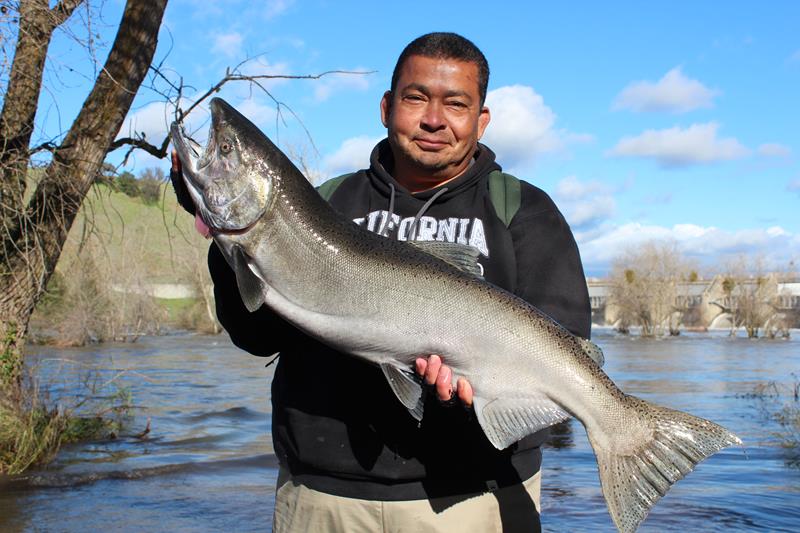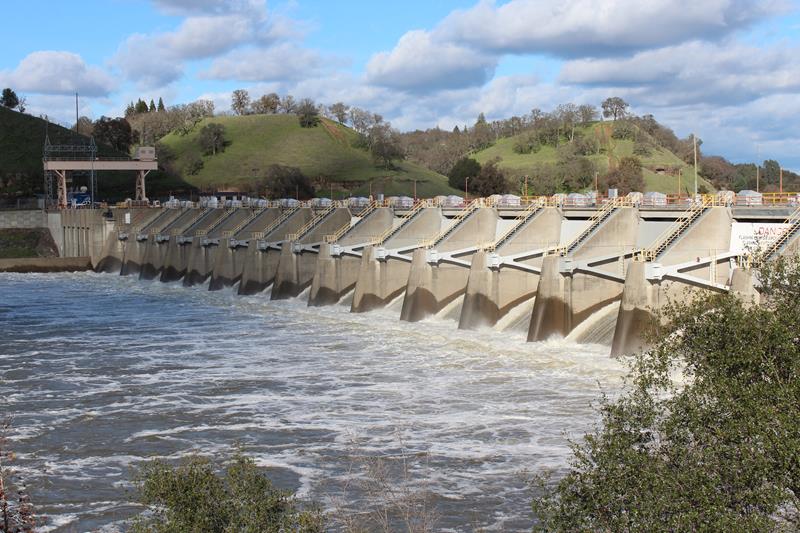In the biggest release of water since 2006, the U.S. Bureau of Reclamation on December 16 increased releases to the American River below Nimbus Dam from 15,000 cubic feet per second to 35,000 cfs.
It was awesome to see these massive flows rushing from below the dam into Nimbus Basin, flooding the trees and brush along the river, the day after the release. As I walked along the river, I was surprised to see three anglers wading at the edge of the inundated road to the basin in an area of slack current between trees.
“Are you catching any fish today?” I asked them.

James Lovejoy of Folsom responded, “Yes, I just caught a nice hen.”
He showed me the salmon on his stringer, a 16 lb. hen that was surprisingly bright.
“It was kind of lethargic coming in,” he noted. “ I caught it on a red and orange bead.”
“The fishing was even better yesterday when I got on the river,” said Lovejoy. “I caught my limit of two kings weighing 20 and 12 pounds.”
His fishing partner, Alvin Bulloda of Sacramento, also experienced great fishing the day before. “I caught a limit of salmon weighing 23 and 16 pounds, and an 18 inch steelhead on beads yesterday,” said Pulloda.
Fishing high water can be dangerous, as evidenced by the number of anglers and homeless people that had to be rescued during the recent high releases.
I have found excellent action several times during high flows. On a February afternoon in 1999 when flows were still 35,000 cfs from storms, I caught and released two steelhead, along with releasing a bright king salmon, while tossing out a silver/blue Little Cleo for only an hour.
Shane Hunt, public affairs officer for Reclamation’s mid Pacific region, said the increased releases to the river were based on “changing conditions and are necessary to maintain space in Folsom Reservoir for projected Sierra runoff.” At press time, the Bureau was slowly ramping down from 35,000 cfs to 5,000 cfs on December 29.

This release occured at a critical time for struggling fall-run Chinook salmon and steelhead on the American. The salmon run is near its end as fish spawn in the river or have already spawned. The winter run of steelhead is starting to move into the river.
Bureau biologists believe that overall, the flows will be beneficial to salmon and steelhead. “The releases will help clean up algae growth and gravel in the river,” said Hunt. “Given the timing, most of the fall Chinooks have already laid their eggs and we don’t think we will see a significant number of new redds because most of the fish have already spawned. As for the steelhead, they haven’t started spawning yet.”
“There may be some minor effect to some of the existing salmon redds from gravel mobilization, but we don’t think it will be a big effect,” said Hunt.
The number of large adult steelhead slated to return to the American this season will probably be sparse, since the lowest number of steelhead on record since Folsom Dam was built returned to Nimbus Fish Hatchery in 2014, with only 154 fish trapped at the facility.
The 2015-2016 run was much better, though by no means a banner run. The hatchery trapped a total of 768 adult steelhead last season, so we should see a better return of large adult steelhead in 2018.
In addition, the hatchery had to release their 450,000 juvenile steelhead in May and June of 2014, rather than the following January and February, as is normally done.
“We had to release the fish in the spring, rather than the following winter, because the Bureau feared the hatchery water temperature would be reach 70 degrees during the drought,” said Gary Novak, hatchery manager. “They figured the fish would have a better chance of survival when released into the river than staying in the hatchery,”
The fish being caught by anglers now are now mostly steelhead in the 18 to 19 inch range.
The recent high flows brought in 50 steelhead to the hatchery on Tuesday, December 20. These fish included 3 tagged Nimbus steelhead weighing 6, 8 and 10 pounds, 9 Coleman strain fish, 35 Central Valley steelhead of undetermined origin and 3 wild non-clipped fish. Prior to that date, hatchery staff had only seen 6 Central Valley steelies of unknown origin at the facility.
“We spawned one pair of Nimbus fish and released the rest back into the river except for the 9 Coleman strain fish that we killed and are studying,” said Novak. “Most of the fish were in the 2 lb. range.”

During 2014, the Bureau of Reclamation conducted an experiment by releasing 150,000 Coleman National Fish Hatchery-strain steelhead into the river.
“This was not done to supplement the American River run, but was a study to find a potential replacement for the current strain of steelhead,” said Novak. “They were looking for an appropriate replacement for the current Eel River strain. We wanted to see if these fish would come back if we raised them at the hatchery. Currently, we have no plans of spawning these fish to replace the current strain of steelhead.”
The salmon run this year appears to be relatively robust, now that the hatchery has finished spawning for the year. The hatchery has taken 8.8 milion eggs this fall, meeting their production goal for the season.
“We trapped 8,726 salmon in the ladder this fall, including 6,926 adults and 1800 jacks. We spawned a total of 3,564 fish,” said Novak.
The major three major state-run hatcheries in the Central Valley – the Nimbus Hatchery in Sacramento County, the Feather River Hatchery in Butte County and the Mokelumne River Hatchery in San Joaquin County – annually take approximately 24 million eggs in order to produce Chinook salmon for release the following spring.
The biggest problem the hatchery staff faced this season at the hatchery was the manipulation of the weir by poachers that resulted in a lot of ripe and nearly ripe salmon destined for the hatchery getting released upriver into Nimbus Basin.

“At the end of the season only 40 to 50 percent of hatchery fish were ripe when it should be more like 75 to 80 percent of the fish,” said Novak. “The poachers were apparently manipulating and moving the bars up and down by loosening and a removing the bolts. The wardens and Sacarmento County sheriff Office looked into the matter, but they weren’t able to catch the poachers in the act.”
The section from the SMUD power line crossing at the southwest boundary of Ancil Hoffman Park downstream to the Jibboom Street Bridge closes to salmon fishing on December 31. On the following day, the steelhead fishing opens in the closed section of the American from the U.S. Geological Survey gauging station cable crossing about 300 yards downstream from the Nimbus Hatchery fish rack site to the to the SMUD power line crossing at the southwest boundary of Ancil Hoffman Park.
Midnight Reservoir Elevation and Flows for Folsom may be found at Reclamation’s Central Valley Operations Office website at https://www.usbr.gov/mp/cvo/vungvari/wtr_rpt.pdf. Current American River conditions may be found at the Department of Water Resources’ California Data Exchange Center website at http://cdec.water.ca.gov/river/americanStages.html.
Lower American River Facts
Location: The 23 miles of the American River from Nimbus Dam to its junction to the mouth are located in the heart of the Sacramento metropolitan area. The entire river is accessible to bank anglers and boaters, since it is located in the beautiful American River Parkway. The parkway is located in a protected greenbelt that cuts Sacramento County in half. It features a paved bicycle and running trail, many rest areas and access from most neighborhoods adjacent to the river parkway.
Fishing Season: The section from Discovery Park to the SMUD powerline at the Southwest Boundary of Ancil Hoffman Park, is open year round to fishing for all except for salmon. The river above the SMUD powerline to the Hazel Avenue Bridge is open to fishing to steelhead and other fishing other than salmon from January 1 through October 31.
The salmon fishing season is set at the Fish and Game Commission meeting every spring. In 2016, the salmon season ran from July 16 to December 31 except for the small section of river from the Jibboom Street Bridge to the mouth that closed on December 16. Review the California Fresh Water Sport Fishing Regulations Booklet for bag and possession limits, hook restrictions and additional restrictions:
Day Use: The entrance fee for vehicles under 22 feet in length is $5.00, except on summer holiday weekends when the fee is $8.00. The fee for trailer or vehicle 22 or more feet in length is $10.00 except for summer holiday weekends when the fee is $13.00.
Annual Fees: Vehicle (private or commercial – $50.00
Motorized watercraft and trailer plus vehicle pass – $100.00.
Boat launching: Concrete boat ramps are available at Discovery Park, Howe Avenue, Watt Avenue and Sunrise. Unimproved gravel launching is available at Gristmill, Ancil Hoffman, Rossmoor and other areas on the river. The fee for non-motorized watercraft is $3 (plus vehicle fee) and the fee for motorized watercraft is $5 (plus vehicle fee).
Park information: www.sacparks.net, Sacramento County Department of Regional Parks, Recreation and Open Space Administration, 3711 Branch Center Rod, Sacramento, CA. 95827. For General Parks, Golf and Rangers Information, call (916) 875-6961.
Fishing Information: Fisherman’s Warehouse, Sacramento, (916) 362-1200; Elkhorn Outdoor Sports, Rio Linda, (916) 991-5298; Broadway Bait Rod & Gun, Sacramento, (916) 448-6338.
